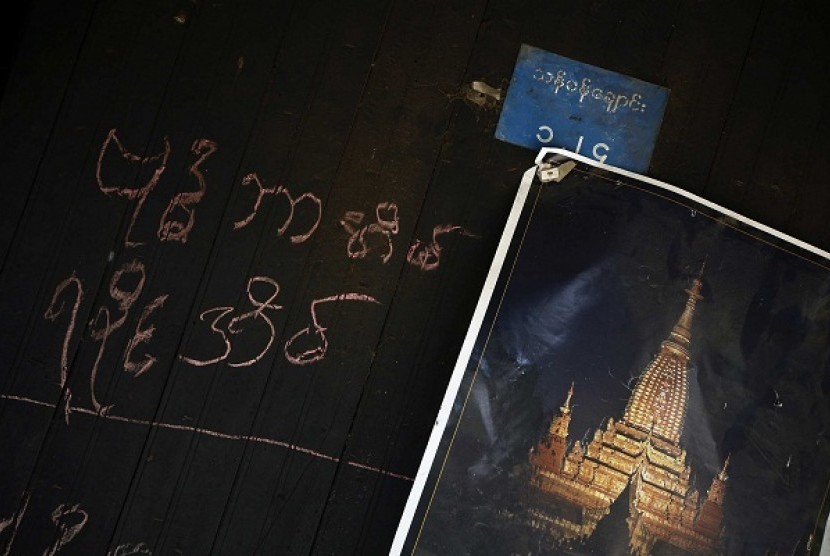Hot ethnic nationalism
REPUBLIKA.CO.ID, PAIK THAY - The last spasm of violence took place at Kyauktaw, a town north of the state capital, Sittwe. At that point, the military shot into the crowd - and, for the first time, killed the Buddhists it had long been accused of siding with.
Soldiers opened fire to prevent Rakhine villagers on two boats from storming a Rohingya Muslim community, said Aung Kyaw Min, a 28-year-old Rakhine from Taung Bwe with a bullet in his leg. "I don't know why the military shot at us," he said. Two people died and 10 were wounded, villagers said.
In a separate incident the same day, security forces shot at Rakhines on Kyauktaw's outskirts, killing two and wounding four, a witness told Reuters.
The shootings seemed to send a message to the mobs. The violence stopped that day.
The senior police officer in Naypyitaw acknowledged that police were forced to fire at both Muslims and Rakhines in their attempts to subdue large crowds.
The official death toll from the October violence now stood at 89. The real toll could be higher. The extent of the killing at Yin Thei village remains unclear. Reports persist that scores of Muslims fleeing Pauktaw drowned after Rakhines rammed their boat. Nearly 4,700 homes were destroyed in 42 villages.
In a statement that Thursday, President Thein Sein warned that the "persons and organizations" behind the Rakhine State violence would be exposed and prosecuted. The mobs were well-organized and led by core instigators, some of whom moved village to village, military sources told Reuters.
In Kyaukphyu, however, police have so far arrested only seven people - six of them for looting. In Mrauk-U township, where most killings occurred, only 14 people have been arrested, said the military intelligence officer. The apparent impunity of the instigators is sending a chilling message to Muslim communities across Myanmar.
The intelligence officer, who has direct knowledge of the state's security operations, identified the suspected ringleaders as Rakhine extremists with ties to the Rakhine Nationalities Development Party, or RNDP, which was set up to contest Myanmar's 2010 general election. He didn't name any suspects. Buddhist monks stoked the unrest with anti-Muslim rhetoric, he added.
RNDP Secretary-General Oo Hla Saw denied that his party organized any mobs. But he acknowledged the possible involvement of supporters, low-level officials and "moderate monks who become radical when they think about Muslims."
Oo Hla Saw blamed local authorities for failing to heed rumors of impending violence, and Islamist radicals for inflaming tensions. For many Rakhines, he adds, the term Rohingya has jihadist overtones associated with the "Mujahid," autonomy-seeking rebels in northern Rakhine State from 1949 to 1961, who called themselves ethnic Rohingya. (Independent historians say the rebels did popularize the term "Rohingya," but cite a few references to it since the 18th century.)
Even today, Oo Hla Saw said, the Rohingya want "to set up an autonomous Islamic community. They are systematically scheming to do that."
Most Rohingya struggle simply to get by. A 2010 survey by the French group Action Against Hunger found a malnutrition rate of 20 percent, far above the emergency threshold set by the World Health Organization.
Many arrived as laborers from Bangladesh under British rule in the 19th century - grounds the government now uses to deny them citizenship. Rohingya were effectively rendered stateless under the 1982 Citizenship Law, which excluded them from the list of indigenous ethnic groups. Officials refer to them as Bengalis. Most Rohingya found it hard to apply for naturalized citizenship, since they couldn't speak Burmese or prove long-term residence.
Monks, symbols of democracy during 2007 protests against military rule, have helped fuel the outrage against Muslims. A week before the violence erupted, monks led nationwide protests against plans by the Organisation of Islamic Cooperation (OIC), the world's biggest Islamic body, to set up a liaison office in Rakhine State.
An anti-OIC rally in Sittwe on October 15 "angered Muslims here," conceded Nyar Nar, 32, one of the Rakhine monks who led it. He regards Muslims as foreign invaders. "As monks, we have morality and ethics," he said. "But if outsiders come to occupy our land, then we will take up swords to protect it."
In some parts of the state, the mood is celebratory. "This is the best time because there are no Muslims here," said Zaw Min Oo, a Rakhine shoe seller in Pauktaw township. Nearly 95 percent of a 20,000-strong Muslim community there is now gone.
The peace might be short-lived. The state's clumsy attempts at segregation helped create the conditions for the October violence. Further segregation - including the confining of tens of thousands of Muslims in seething camps - could spark more violence. Curfews remain in force across much of Rakhine State.
In Kyaukphyu town, starving dogs sniff through the ashes while municipal workers heave scrap metal into a truck. The only Muslim left in town is Ngwe Shin, an old woman suffering from mental illness. She can often be found near the market, shuffling past vandalized or shuttered homes.


